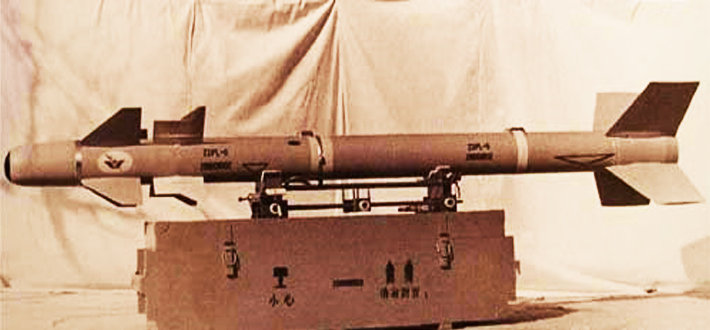| PL-6 air-to-air missile
中国PL-6空对空导弹 Date:2020-11-10 Source:wikia By:Globalmil Viewed: |

Due to the prolonged delay of PL-3 AAM development, PL-3 AAM was already inadequate before its completion. A follow-up was planned to incorporate advance in microelectronics and lessons learned in the aerial combats, which is based on the feedback of Vietnam War. The reason for starting a new AAM was because of the inherit design limitation of PL-3 back then, it was difficult to incorporate the technological advances planned to be incorporated. The program was designated as PL-6 and begun in 1975, before PL-3 program was even completed. The main contractor was the 612th Research Institute (later reorganized as Luoyang Electro-Optics Technology Development Centre (EOTDC)).
由于PL-3空对空导弹(AAM)的开发时间过长,因此PL-3 AAM在完成之前就已经落后。根据越南战争的反馈,计划采取后续行动,以结合微电子技术的进步和在空战中汲取的经验教训。启动新的空对空导弹(AAM)的原因是因为当时PL-3的继承设计局限性,因此难以纳入计划中的技术进步。该计划被指定为PL-6,于1975年开始,甚至在PL-3计划完成之前。主要承包商是第612研究所(后改组为洛阳光电技术发展中心(EOTDC))。
The first batch of missile was completed in 1978 and tests were successfully completed in 1979. However, PL-6 met the same fate of its predecessor, PL-3 in that during training and evaluations, it was revealed that PL-6 did not significantly outperform PL-3, and furthermore, all experience gained from PL-6 can be readily incorporated in the PL-2 improvement efforts, so there was no need to have an additional separate AAM program when the requirement could be meet by just one. Consequently, PL-6 program was drastically scaled back in 1981, and after very limited production, PL-6 was terminated in 1983.
第一批导弹于1978年完成,并于1979年成功完成了测试。但是,PL-6遇到了其前身PL-3的同样命运,因为在训练和评估过程中,PL-6并没有明显改善优于PL-3,而且从PL-6获得的所有经验都可以轻松地纳入PL-2的改进工作中,因此,只要一个单独空对空导弹(AAM)计划可以满足要求时,就无需另外制定空对空导弹(AAM)计划。因此,PL-6计划在1981年进行了大规模缩减,在非常有限的生产之后,PL-6项目于1983年终止。
Max range: 11.5 km
Min range: 1.3 km
Max speed: Mach 2.5
Max altitude: 23 km
Max g force: 29 g
Weight: 93 kg
Length: 2.123 m
Diameter: 135 mm
Wingspan: 654 mm
最大射程:11.5公里
最小射程:1.3 公里
最高速度:2.5马赫
最高海拔高度:23公里
最大过载:29g
重量:93公斤
长度:2.123米
直径:135毫米
翼展:654毫米
引信:红外近炸引信
制导系统:被动红外
最大速度:2,450千米/小时
补充资料:《霹雳-6(PL-6)》来源:互联网
“霹雳”6空空导弹是中国机载导弹武器开始由高空高速向重视格斗空战方向发展的体现,是为中国战斗机与国外七十年代装备的新型战斗机对抗的需要而开发的机载导弹武器。霹雳-6型导弹的发展是配合当时所提出的多个格斗战斗机的型号而进行的,而最后没有完成项目的开发和试验工作的根本原因,除了因为技术上存在有一些短期无法解决的问题之外,从国外引进的霹雳-8在整体技术性能和技术成熟程度上都要超过霹雳-6的指标,而当时中国无论是在资金上还是在实际需要上都不能支持过多的型号发展也是一个重要的原因。
补充资料:《霹雳-6(PL-6)》来源:互联网
“霹雳”6空空导弹是中国机载导弹武器开始由高空高速向重视格斗空战方向发展的体现,是为中国战斗机与国外七十年代装备的新型战斗机对抗的需要而开发的机载导弹武器。霹雳-6型导弹的发展是配合当时所提出的多个格斗战斗机的型号而进行的,而最后没有完成项目的开发和试验工作的根本原因,除了因为技术上存在有一些短期无法解决的问题之外,从国外引进的霹雳-8在整体技术性能和技术成熟程度上都要超过霹雳-6的指标,而当时中国无论是在资金上还是在实际需要上都不能支持过多的型号发展也是一个重要的原因。
上一篇:PL-5 air-to-air missile 下一篇:PL-7 air-to-air missile
| PL-20/PL-21 active radar-guided ultra-long-range air-to-air missile
综述:中国PL-20/PL-21型主动雷达制导超远程空对空导弹 |
| The PL-21 (Thunderbolt-21) missile is considered to be an active radar-guided ultra-long-range air -to - air missile independently developed by China .... [2022-04-24] |
| PL-15/Pili-15 Air-to-Air Missile
综述:PL-15/"霹雳-15型“(Pili-15)空对空导弹 |
| The Pili-15 was developed by the China Air-to-Air Missile Research Institute. ... [2022-02-15] |
| PL-15 air-to-air missile
PL-15空空导弹 |
| The PL-15 (Chinese: 霹雳-15; pinyin: Pī Lì-15; literally: "Thunderbolt-15") is an active radar-guided very long range air-to-air missile developed by the People's Republic of China.... [2022-02-05] |
| PL-14 Air-to-Air Missile
中国PL-14空空导弹 |
| The PL-14 is a very poorly attested designator that is only mentioned in passing in a few Chinese sources. ... [2022-02-03] |
